Free E-Mail
Bible Studies
Beginning the Journey (for new Christians). en Español
Old Testament
Abraham
Jacob
Moses
Joshua
Gideon
David, Life of
Elijah
Psalms
Solomon
Songs of Ascent (Ps 120-135)
Isaiah
Advent/Messianic Scriptures
Daniel
Rebuild & Renew: Post-Exilic Books
Gospels
Christmas Incarnation
(Mt, Lk)
Sermon on the Mount
(Mt 5-7)
Mark
Luke's
Gospel
John's Gospel
7 Last Words of Christ
Parables
Jesus and the Kingdom
Resurrection
Apostle Peter
Acts
The Early Church
(Acts 1-12)
Apostle Paul
(Acts 12-28)
Paul's Epistles
Christ Powered Life (Rom 5-8)
1 Corinthians
2 Corinthians
Galatians
Ephesians
Vision for Church
(Eph)
Philippians
Colossians,
Philemon
1
& 2 Thessalonians
1 & 2 Timothy,
Titus
General Epistles
Hebrews
James
1 Peter
2 Peter, Jude
1, 2, and 3 John
Revelation
Revelation
Conquering Lamb of Revelation
Topical
Glorious Kingdom, The
Grace
Great Prayers
Holy Spirit, Disciple's Guide
Humility
Lamb of God
Listening for God's Voice
Lord's Supper
Names of God
Names of Jesus
Christian Art
About Us
Podcasts
Contact Us
Dr. Wilson's Books
Donations
Watercolors
Sitemap
Day 21. The Lamb Who Is the Temple (Revelation 21:22)
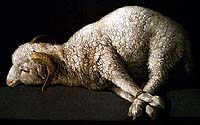 Francisco de Zurbaran (1598-1664), 'Agnus Dei' (1635-40) ,Canvas 38 x 62 cm. Museo Nacional del Prado, Madrid. Larger image. |
The Book of Revelation is coming to a climax. Chapter 20 describes the Great White Throne Judgment and the grace-filled Lamb's Book of Life. Chapter 21 turns to the New Heavens and the New Earth. The heavenly Jerusalem descends to earth as a bride adorned for her husband; indeed, in a sense, the Holy City is the Bride of the Lamb, as God comes to dwell with his people. The city is described with all its adornments and precious stones and pearls. Now the focus shifts to the temple -- but there is no temple!
"And I saw no temple in the city,
for
its temple is the Lord God the Almighty and the Lamb." (Revelation
21:22)
Physical or Spiritual?
We were expecting a temple or a tabernacle. After all, the author of Hebrews says of the tabernacle in the wilderness and later the temple: "They serve a copy and shadow of the heavenly things" (Hebrews 8:5).
"Christ has entered,
not into holy places made with hands,
which are copies of the true things,
but into heaven itself,
now to appear in the presence of God on our behalf." (Hebrews 9:24)
And God's temple has been mentioned several times in Revelation previously.
- "A pillar in the temple of my God" (3:12).
- "Serve him day and night in his temple" (7:15).
- "Rise and measure the temple" (11:1-2).
- "God's temple in heaven was opened" (11:19).
- "Another angel came out of the temple in heaven" (14:17).
- "I heard a loud voice from the temple" (16:1).
- "A loud voice came out of the temple" (16:17).
I can hear some of you shouting. "It says there was a temple, so there must be a temple!" Calm down. We're beginning to understand that physical tents and temples are a way of understanding in earthly terms the heavenly and spiritual reality of God's holy presence. We live in a physical world in which it is nearly impossible to imagine something physical that we cannot see, feel, or touch. But heaven is not confined to our language deficiencies.
John is trying to describe the City of God in earthly terms, but it is a spiritual reality that goes far beyond our meager ability to explain in human language. And so John depicts these spiritual realities in symbolic ways to convey the substance.
The Tabernacle Furnishings and Areas
What does it mean that there is no temple? Perhaps we begin by looking at the tabernacle in the wilderness, the precursor of the temple in Jerusalem.
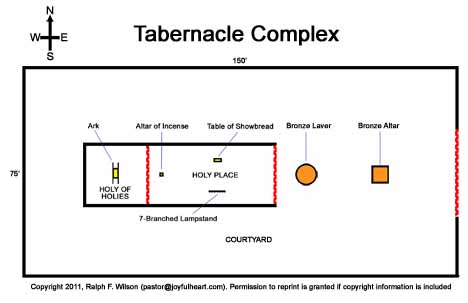
Tabernacle Complex.
Larger image.
You can look at the earthly tabernacle and temple in terms of objects.
- Bronze altar for animal sacrifices to atone for sin, but Christ's once-for-all sacrifice has been complete. There's no need for further sacrifices.
- Bronze laver is for washing and cleansing, but we have been made clean in the blood of the Lamb.
- Table of showbread is a symbol of providing food for the monarch, but it is clear that the King is a spirit-being, not a physical one who needs food.
- 7-branched lampstand is for providing light, but our verse tells us that "its lamp is the Lamb."
- Altar of incense is to make the air fragrant in the presence of the monarch, but now the petitions of the saints are the fragrance before the throne.
- Ark of the covenant is to be the portable seat of the King. But what meaning does a seat or throne have for a spirit-being, really?120
Christ Removes the Barriers
Another way to view the tabernacle or temple is in terms of barriers and separations designed so that a holy God may live in the midst of a sinful people.
- Courtyard is the first barrier, excluding all but the priests and those offering a sacrifice.
- Veil to the Holy Place excludes all but the priests.
- Veil to the Holy of Holies excludes all but the high priest, and him only once a year.
But the sacrifice of Christ on the cross is designed to remove the barriers between God and man.
"Jesus uttered a loud cry and breathed his
last.
And the curtain of the temple was torn in two,
from top to bottom." (Mark 15:37-38)
Surely, the meaning of this is that Jesus opens the way to the very presence of God. Access to God is our gift and privilege, even now.
"Let us then with confidence draw near to the
throne of grace,
that we may receive mercy and find grace to help in time of
need."
(Hebrews 4:16)
Rather than God being hidden, separated from his people, in the New Jerusalem, "they will see his face" (Revelation 22:4a, Day 24).
Sometimes I think that the familiar traditions of our churches sometimes create a kind of formal barrier. The songs, the order, the beauty are welcome and comforting, but they are no substitute for the Lamb himself. They only begin to touch the edges of God's reality; they can't reproduce the Almighty's fullness and height and depth and intimacy.
Its Temple is God and the Lamb (Revelation 21:22)
So what does our passage mean?
"And I saw no temple in the city, for its temple is the Lord God the Almighty and the Lamb." (Revelation 21:22)
Previous mentions of the temple in Revelation are used as symbols to convey certain truths. But in the final analysis, in the New Jerusalem, there is nothing between us and God. There we are in his presence -- the Father and the Lamb -- in a city that he has created for us.
Remember when Jesus reassures his disciples prior to his death,
"2 In my Father's house are many
rooms.
If it were not so, would I have told you
that I go to prepare a place for you?
3 And if I go and prepare a place for you,
I will come again and will take you to myself,
that where I am you may be also." (John 14:2-3)
This glorious city in all its adornments is a way of describing the glorious presence of God with his people, the Lamb surrounded by his beloved, blood-bought friends -- you and me. There is no temple any longer -- no need for separations of holiness -- for he has made us all holy before him.
Our destiny, my friend, is to dwell, to "hang out" with our Lord forever. If you don't love him now, that probably seems like a boring eternity. But as you seek him, as you get to know him and love him, you'll begin to look forward to this.
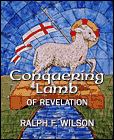 Available in PDF, and Kindle formats, |
And the invitation that we have seen before is extended afresh to you today.
"The Spirit and the Bride say, 'Come.'
And let the one who hears say,
'Come.'
And let the one who is thirsty come;
let the one who desires take the water of life without price." (Revelation
22:17)
Prayer
Father, sometimes the traditions of our faith have brought us reassurance of Your reality, but not the glorious immediacy of Your Presence. Help us move beyond the outward trappings of our faith to the Center, where all the structures fall away and there is just You. We draw near to You and to the Lamb. We seek You afresh today. In Jesus' name, we pray. Amen.
Day 21 Meditation (Revelation 21:22). How did the
Tabernacle in the Wilderness and the Temple in Jerusalem create barriers between
the people and a holy God? How can our traditional forms of Christian worship
keep us from full intimacy with God? In what sense do we understand that the
"temple is the Lord God Almighty and the Lamb"?
https://www.joyfulheart.com/forums/topic/1895-day-21-temple/
Endnotes
(References and Abbreviations)
[120] In Revelation we see references to an altar (6:9; 11:1; 14:18; 16:17), an altar of incense (8:3, 5), and the ark of the covenant (11:19). However, there is no mention of the table of showbread, or the 7-branched lampstand (though the light of the city is referenced in 21:23-24; 22:5).
Copyright © 2025, Ralph F. Wilson. <pastor![]() joyfulheart.com> All rights reserved. A single copy of this article is free. Do not put this on a website. See legal, copyright, and reprint information.
joyfulheart.com> All rights reserved. A single copy of this article is free. Do not put this on a website. See legal, copyright, and reprint information.
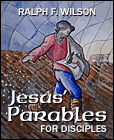
|
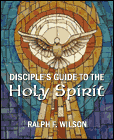
|
In-depth Bible study books
You can purchase one of Dr. Wilson's complete Bible studies in PDF, Kindle, or paperback format -- currently 48 books in the JesusWalk Bible Study Series.
Old Testament- Abraham, Faith of
- Jacob, Life of
- Moses the Reluctant Leader
- Joshua
- Gideon
- David, Life of
- Elijah
- Psalms
- Solomon
- Songs of Ascent (Psalms 120-134)
- Isaiah
- 28 Advent Scriptures (Messianic)
- Daniel
- Rebuild & Renew: Post-Exilic Books
Gospels
- Christmas Incarnation (Mt, Lk)
- Sermon on the Mount (Mt 5-7)
- Luke's Gospel
- John's Gospel
- Seven Last Words of Christ
- Parables
- Jesus and the Kingdom of God
- Resurrection and Easter Faith
- Apostle Peter
Acts
Pauline Epistles
- Romans 5-8 (Christ-Powered Life)
- 1 Corinthians
- 2 Corinthians
- Galatians
- Ephesians
- Philippians
- Colossians, Philemon
- 1 & 2 Thessalonians
- 1 &2 Timothy, Titus
General Epistles
Revelation
Topical
